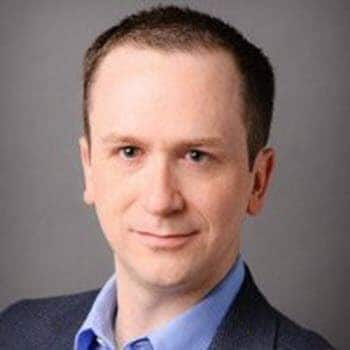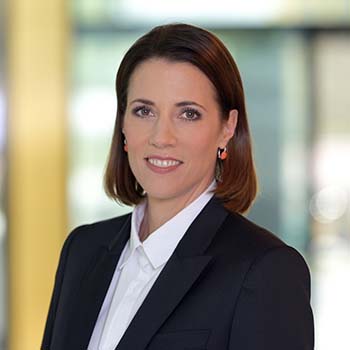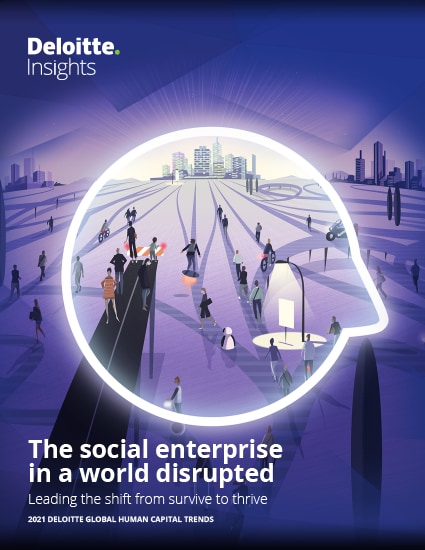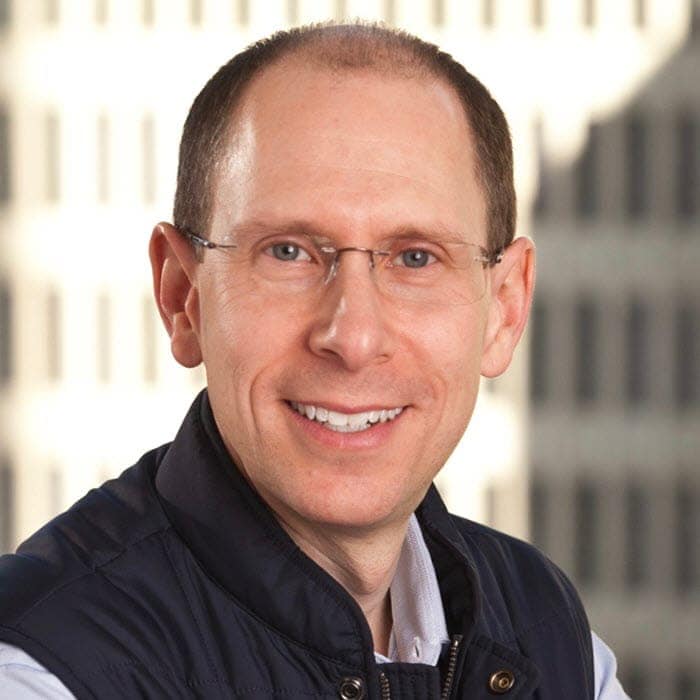
Introduction The social enterprise in a world disrupted
Making the shift from “survive to thrive” depends on an organization becoming distinctly human at its core—a different way of being that approaches every question, every issue, and every decision from a human angle first.
In 2020, COVID-19 forced organizations around the world to enact radically new ways of working and operating amid the pandemic’s human and economic impacts. Organizations had to respond to a sudden, unforeseen crisis whose rapidly changing nature confounded efforts to predict and plan for events. The pandemic brought into sharp relief the pitfalls of strategies that envision moving from point A to point B on a static path, and that assume that one has years, not months or weeks, in which to rethink outdated views and establish a new set of truths. As we all learned the hard way, in an environment that can shift from moment to moment, the paths and time frames to achieving one’s goals must shift as well.
Learn more
Explore the 2021 Human Capital Trends collection
Revisit the 2020 Human Capital Trends
Order a copy of Work Disrupted, Deloitte’s new book on the accelerated future of work
Explore five characteristics of a resilient organization
Explore The future of work in a post-pandemic world
Vist our Dbriefs webcast on-demand
Learn about Deloitte’s services
Go straight to smart. Get the Deloitte Insights app
Create a custom PDF
Having a plan to deal with the unexpected, as important as it is, isn’t all organizations need in such an environment. Even more necessary is to make a fundamental mindset shift: from a focus on surviving to the pursuit of thriving.
In a world of perpetual disruption, a focus on surviving restricts one’s aspirations to accepting each new reality and working within it to accomplish what an organization has always done. A survival mindset views disruptions as point-in-time crises to be addressed with the expectation that the organization will revert to “business as usual” once the crises are over. Organizations with a survival mindset aim to deal with the reality that the world imposes; it’s about doing what’s necessary to succeed today.
The pursuit of thriving, in contrast, orients organizations toward welcoming each new reality and using it to reimagine norms and assumptions in ways that were not possible before. A thrive mindset recognizes that disruption is continuous rather than episodic, and embraces disruption as a catalyst to drive the organization forward. Organizations with a thrive mindset aim to create new realities that they choose for themselves; it’s about doing what’s possible, not just to succeed today, but also to dominate tomorrow.
It’s our view that the shift from survive to thrive depends on an organization becoming—and remaining—distinctly human at its core. This is not just a different way of thinking and acting. It’s a different way of being, one that approaches every question, every issue, and every decision from a human angle first. And it’s not just a good idea, but a mandate for growth. Today’s environment of extreme dynamism calls for a degree of courage, judgment, and flexibility that only humans and teams led by humans can bring. A predictable world can be effectively dealt with by algorithms and equations. A messy world cannot, even in an age of increasingly intelligent machines.
Being distinctly human at the core is the essence of what it means to be a social enterprise. To combine revenue growth and profit-making with respect and support for its environment and stakeholder network, an organization needs to ground itself in a set of human principles: purpose and meaning, ethics and fairness, growth and passion, collaboration and relationships, and transparency and openness.1 The human focus these principles bring to an organization is what puts the social enterprise in a position to thrive—to continually reinvent itself on the back of perpetual disruption.
Preparedness stems from a “thrive” mindset
In the 2021 Deloitte Global Human Capital Trends report, we set out to understand what characteristics can support organizations in the shift from survive to thrive. We started our exploration by asking a paradoxical question: How can organizations position themselves to thrive when they are focused on making the changes necessary to survive?
To find out, we surveyed 6,000 professionals across every industry, sector, and region of the globe, with 99 countries participating. 3,630 of this year’s respondents were senior executives. And, for the first time in the survey’s 11 years, business executives outnumbered HR executives, underscoring the importance they placed on human capital issues in the COVID-19 crisis. We asked them about their experiences since the pandemic began, seeking to understand how the crisis affected the way they viewed organizational preparedness, the challenges and opportunities they expected to face in future disruptions, and their plans for approaching work transformation strategies moving forward.
From this research, we learned that the organizations that were best prepared for the COVID-19 crisis were already adopting a “thrive” mindset of using disruption as an opportunity to propel the organization forward. The 15% of executives who said that their organization was “very prepared” for the pandemic were 2.2 times more likely to pivot investments for changing business demands. The “very prepared” group was also twice as likely to use technology to transform work. And most importantly, those who were “very prepared” were twice as likely to recognize the importance of organizing work to facilitate rapid decision-making and nearly three times more ready to leverage worker adaptability and mobility to navigate future disruptions.
While it may not be obvious, these last findings highlight that organizational preparedness hinges on the ability to bring human strengths such as decision-making and adaptability to the fore, not just during a point-in-time crisis, but continually. It means perpetually cultivating resilience, courage, judgment, and flexibility in order to navigate a turbulent reality. And it means taking the creativity unleashed by the need to survive a crisis—the creativity that is a hallmark of being human—and using it to reinvent the organization and its future. COVID-19 proved that people and organizations are capable of tremendous growth under the pressure of a crisis. The challenge for many will be to sustain that momentum to discover new ways to thrive in the long term, even as disruption constantly resets the path forward.
Elevating the “human” in human capital
In contrast to the idea that disruption can be a catalyst for reinvention, many human capital topics, and particularly those we’re exploring in more depth in this report, have traditionally been approached through discrete programs and initiatives. As organizations make the shift from survive to thrive, these solutions need to become dynamic so that they can better support the human strengths that enable the broader organization to flourish. In the following chapters, we dive deeper into five topics we wrote about in our 2020 Deloitte Global Human Capital Trends report to further explore how organizations can bring out the human strengths that make organizational thriving possible:
- Integrating workers’ physical, mental, financial, and social health into the design of work itself rather than addressing well-being with adjacent programs. Embedding well-being into work design helps workers experience well-being while they do their work, not just when they’re away from it. This is good for organizations as well as workers: Work that addresses the human need for quality of life can motivate people to give their best when on the job.
- Capitalizing on worker agency and choice as the means to drive learning, adaptability, and impact. Giving workers more control over what work they do and what learning experiences to pursue can increase their engagement because it allows them to focus their efforts on things that truly matter to them. Aligning workers’ passions and interests with organizational needs can improve an organization’s performance as well, again because workers are more motivated and engaged in their work and learning.
- Creating teams and superteams that use technology to enhance natural human ways of working. The thoughtful use of technology makes it possible to change the nature of work so that it makes the most of people’s distinctly human capabilities. From collaboration tools that enhance teaming and connection to artificial intelligence technologies that can guide people in making decisions, technologies integrated with humans on teams can enable those teams to pursue new and better outcomes at greater speed and scale.
- Developing and acting on forward-looking insights using real-time data to harness workforce potential. Understanding the workforce is the first step to aligning their behavior with organizational objectives in ways that recognize workers’ needs, develop their capabilities, and respect their values and those of the organization. Insights into what work is being done and how people are doing it can help organizations craft new ways of working that bring out the latent potential in every worker.
- Shifting HR’s role from standardizing and enforcing workforce policies to a new responsibility of re-architecting work across the enterprise. For an organization to truly become human at its core, HR must take the lead in embedding human considerations into every aspect of work, collaborating with business and other functional leaders to reimagine the what, why, who, and how of work across the entire organization.
Our May 2020 special report challenged organizations to leverage the COVID-19 pandemic as an opportunity to embrace possibility: to explore how they could draw energy from the pandemic’s chaos and disruption and return to work by designing the future of work.2 Seven months later, that challenge is even more relevant as we learn more about how the focus on the human dimension of work is guiding organizations as they forge a path forward. Organizations that use disruption as an opportunity to embody human qualities will enable them to thrive through disruption. Organizations that do not will quickly fall behind.
The 2021 Global Human Capital Trends
In this report, we explore the journey from survive to thrive through the lens of five of our 2020 Global Human Capital Trends:
Designing work for well-being: The end of work/life balance
- The Trend: Organizations are taking well-being beyond work/life balance by starting to design well-being into work—and life—itself.
- Surviving: Supporting well-being through programs adjacent to work.
- Thriving: Integrating well-being into work through thoughtful work design.
Beyond reskilling: Unleashing worker potential
- The Trend: Organizations need a workforce development approach that considers both the dynamic nature of work and the equally dynamic potential of workers to reinvent themselves.
- Surviving: Pushing training to workers from the top down, assuming the organization knows best what skills workers need.
- Thriving: Empowering workers with agency and choice over what work they do, unleashing their potential by allowing them to apply their interests and passions to organizational needs.
Superteams: Where work happens
- The Trend: COVID-19 has taught organizations that teams are even more important to thriving amid constant disruption than they might have thought before.
- Surviving: Using technology as a tool to make teams more efficient.
- Thriving: Integrating humans and technology into superteams that use their complementary capabilities to re-architect work in more human ways.
Governing workforce strategies: Setting new directions for work and the workforce
- The Trend: Organizations are looking for forward-facing insights about their workforce that can help them quickly pivot and set new directions in the face of uncertainty.
- Surviving: Using metrics and measurements that describe the workforce’s current state.
- Thriving: Accessing and acting on real-time workforce insights that can support better, faster decisions based on an understanding of what the workforce is capable of in the future.
A memo to HR: Accelerating the shift to re-architecting work
- The Trend: Thanks to their handling of COVID-19’s challenges, HR organizations have earned the right to expand HR’s remit to re-architecting work throughout the enterprise.
- Surviving: Having a functional mindset that focuses on optimizing and redesigning HR processes to manage the workforce.
- Thriving: Embracing an enterprise mindset that prioritizes re-architecting work to capitalize on unique human strengths.
Appendix: Survey demographics
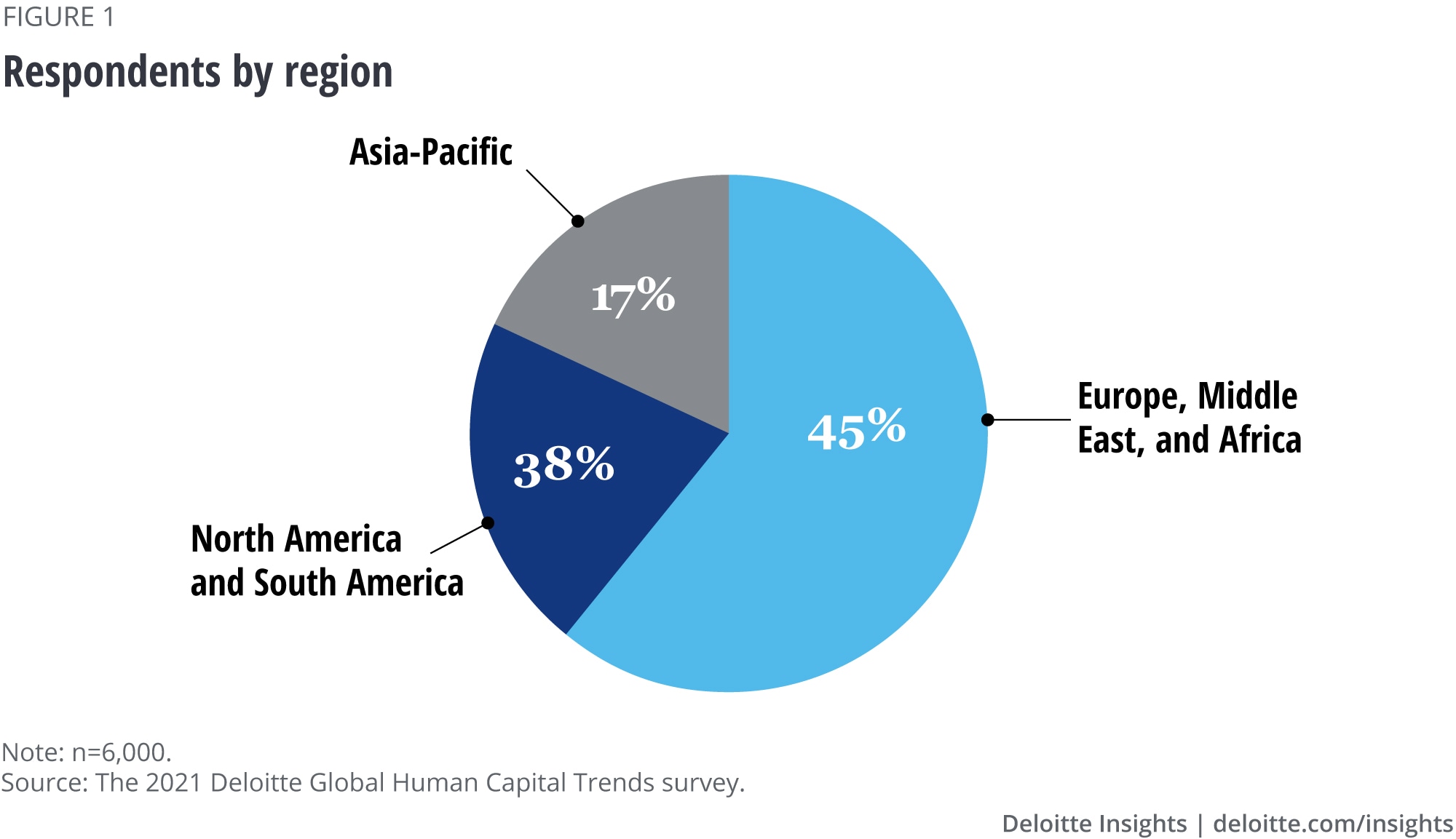
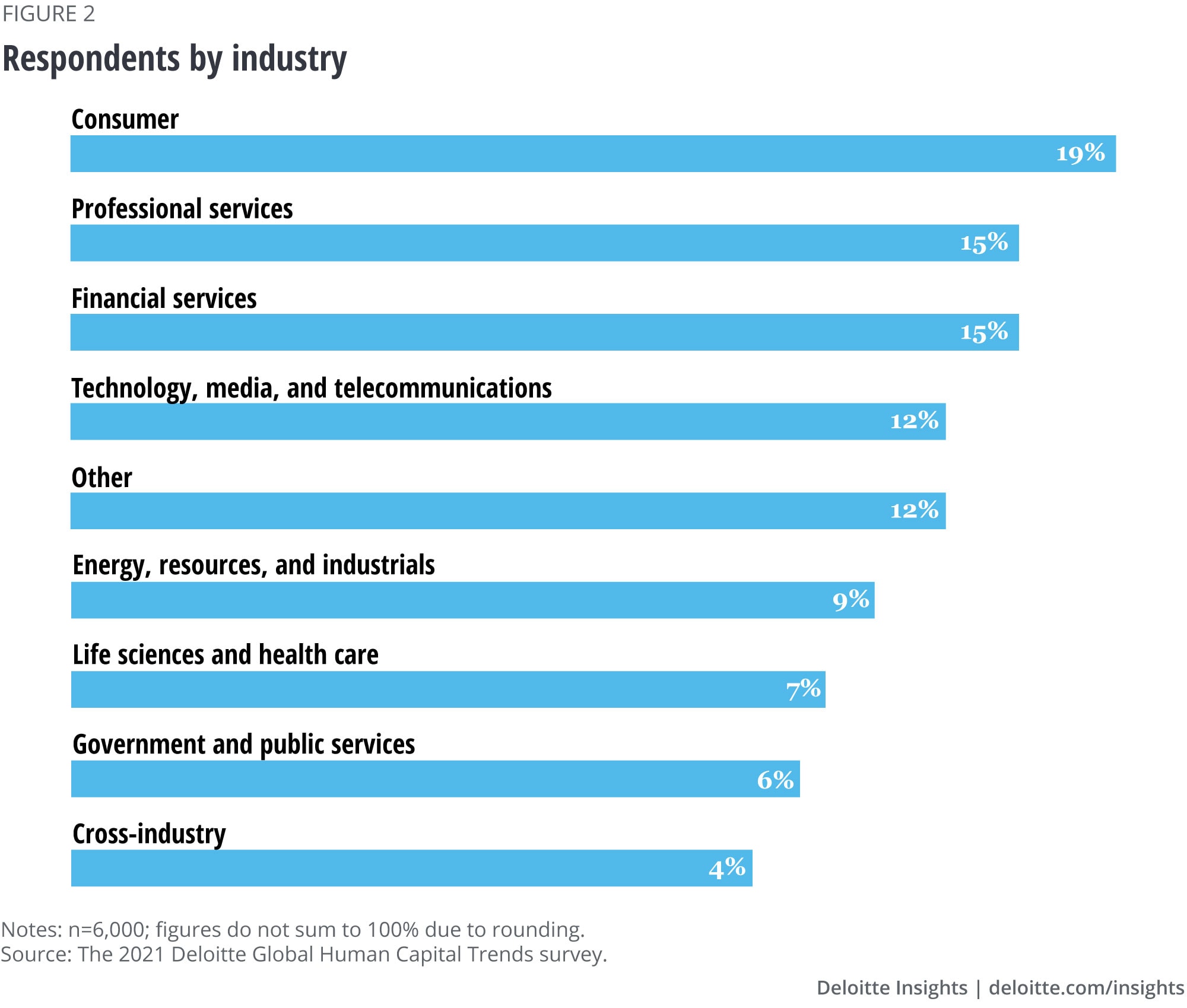


Explore the collection
-
Diving deeper Article3 years ago
-
2021 Global Human Capital Trends: Leading the shift from survive to thrive Article3 years ago
-
Superteams Article4 years ago
-
Introduction Article4 years ago
-
The alternative workforce Article5 years ago
-
The postgenerational workforce Article4 years ago


